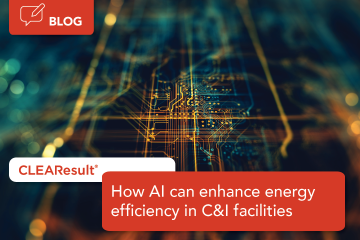Go back




Commercial & Industrial
Discover CLEAResult’s latest articles on Commercial & Industrial and stay informed on the biggest trends for a greener and more sustainable future.

Commercial new construction projects have a unique opportunity to implement energy-efficient design and construction strategies that significantly improve energy performance, reduce carbon footprints and improve long-term operational efficiency. Yet, these projects face many challenges, including , supply chain delays, complex building codes and permitting – factors that can often overshadow energy-related considerations. Building codes and tax incentives in many jurisdictions can help push projects in the right direction, but stakeholders (including architects, contractors, financiers and eventually tenants) need additional support to bring energy efficiency to the forefront of these conversations. This creates a tremendous opportunity for utility programs to engage with stakeholders, provide valuable energy-efficient resources, and shape the future of new buildings by advancing high-performance, sustainable development. Why are new construction programs important? New construction programs, led by utilities or other energy program providers, help ensure that stakeholders not only consider sustainability, energy usage and grid connectivity when developing a new project, but also provide education and incentives to drive energy-conscious decisions. Energy savings: Perhaps most importantly, new buildings provide a huge energy savings opportunity for utility programs and their customers. Some large commercial buildings can use as much energy as an entire neighborhood of single-family homes, and large-scale data centers may use . Finding ways to reduce energy usage helps utilities reduce the load on the grid and can help lower operating costs for the building owner or future tenants. When utilities fail to engage with these projects during the design phase, they risk missing out on significant cost-effective energy savings – opportunities that could enhance program flexibility and support a more diverse portfolio of energy solutions. Shaping building trends and workforce development: A crucial aspect of these programs is educating stakeholders at every stage of the project. New construction programs can empower architects to assess the energy impact of design choices and equipment selection while considering the costs and benefits of onsite generation and storage. They also support contractors in implementing energy-efficient designs during construction and sourcing high-efficiency equipment. This training and collaboration helps transform the market for these services, ensuring more building design professionals proactively integrate energy efficiency into future projects. Decades of energy-efficient design: The usable life of a new building should stretch into many decades, so it’s critical to consider energy impact during design and construction to minimize or avoid future retrofitting. Prioritizing energy efficiency from the start helps utilities stay ahead of demand while adding valuable assets to existing and future grid-connected programs, such as demand response, for years to come. How do new construction programs provide incentives for energy-efficient design?There are several ways commercial new construction programs can help shift projects toward more energy-efficient designs, including: Financial incentives: Like many energy efficiency programs, one of the easiest ways to help customers make a more efficient choice is to provide rebates or incentives. In new construction programs this can take many forms, including prescriptive incentives for new energy-efficient equipment installed in the building or performance-based incentives based on how much more efficient the building is over code. Design assistance resources: It’s imperative that architects and builders understand the impact of their decisions on energy usage as early as possible in the design phase. Incentivizing key stakeholders to attend design charrettes helps put efficiency on the table as an important value-add for all involved. Additionally, utility programs can streamline the process by providing valuable technical resources, l… energy modeling through strategic partnerships, to simplify energy-efficient building design. Training and education: Many architects, contractors and other building stakeholders could have an appetite for energy-efficient design, they just don’t know enough about it yet. By providing training, expert connections and valuable resources, these programs can help them expand their expertise in energy-efficient design, equipment and materials. This knowledge makes their services even more marketable to clients. Training and education are especially important in , where exposure to green or sustainable building practices may be limited.We are proud to collaborate with a network of forward-thinking partners on that set the standard for excellence. But we need to continue to expand the impact of these programs beyond just urban centers to all communities across the U.S. and Canada. By working in tandem with other utility program offerings, we can help customers save energy and money, reduce the need for new transmission and infrastructure, and build a more sustainable, resilient energy future.
Blog .

Utilities are adopting market transformation strategies to drive lasting change in the energy efficiency landscape. At the 2024 CLEAResult Energy Forum, industry experts discussed how utilities can use market transformation programs to promote new approaches and technologies that reshape the market. They explained how market transformation differs from traditional energy efficiency (EE) programs and shared strategies utilities can use to create long-lasting change as the market continues to evolve. What is market transformation?Market transformation programs aim to create permanent, sustained changes in the market. Unlike traditional EE programs that focus on short-term savings, market transformation programs seek to change the way the market operates even after program interventions end. This means moving beyond rebates and incentives and focusing on upstream changes, such as influencing manufacturers and distributors to adopt new standards. One panelist from Northwest Energy Efficiency Alliance (NEEA) explained that one challenge is that market transformation can seem intangible because it targets structural changes at the market level. NEEA relies heavily on logic models to identify barriers and develop specific metrics to track whether the market is moving in the desired direction. This approach helps utilities better understand their progress and demonstrate success in a way that’s measurable and transparent. Using federal and state funding to drive market transformation effortsNew federal and state funding, such as the Inflation Reduction Act (IRA), provides a unique opportunity for utilities to develop market transformation programs that can sustain demand for energy efficiency services long-term. It was noted that the IRA requires states to file market transformation plans to access funding, ensuring that new programs are designed to create continued demand even after the funding ends. Overcoming challenges in market transformation programsImplementing market transformation programs comes with challenges, especially for utilities that are tied to immediate savings goals. Some programs justify the value of educational and training programs by showing how these efforts lead to greater adoption of energy-efficient technologies over time. NEEA emphasized that collaboration with manufacturers, distributors, and other stakeholders is key. For example, NEEA worked with manufacturers to introduce heat pump dryers to the U.S. market—demonstrating how partnerships can accelerate adoption and transform the market. Key takeawaysFocus on lasting change: Market transformation aims for permanent changes that continue after the program ends.Use federal funding strategically: Align new programs with federal and state funding requirements to sustain demand for energy efficiency.Collaboration is key: Work with partners and stakeholders to overcome barriers and drive upstream changes.Measure success with data: Use data to track progress, adoption rates, and long-term outcomes. Check out more lessons learned from our 2024 CLEAResult Energy Forum conference.
Blog .

Grocery stores have long been key players in energy efficiency and demand response programs due to their high energy use and narrow profit margins. These factors make grocers eager to cut energy costs, which presents utilities with significant opportunities for energy savings and participation in energy efficiency or energy transition programs. As regulations change, the focus for many grocers may shift to the refrigerants used in refrigeration systems. While refrigerants haven't been a traditional target for energy efficiency efforts, new pilot programs suggest there is potential for utility partnerships to discover new savings here, redefining the future of energy programs.The transition from hydrofluorocarbon refrigerants In 2020, the began a phasedown, transitioning away from hydrofluorocarbon (HFC) refrigerants. Yet HFCs are still the main refrigerants used today and have a very high global-warming potential (GWP), making them a strong target for climate policy. This year marks the second step of the phasedown, whereby the total GWP of refrigerants produced in the U.S. needs to be 40% lower than the baseline from 2013. The market is already seeing the results of this. With manufacturers focusing on producing more low-GWP refrigerants, prices have significantly increased for commonly used high-GWP refrigerants like R-404A and R-134a. The lack of availability and price increases should compel grocers to look for low-GWP alternatives sooner rather than later. One of the first places they may turn is utility programs offering energy efficiency incentives that will offset some of the costs of this transition. However, there are challenges for utilities looking to integrate new refrigerants into their existing programs. Identifying energy savings in refrigeration Switching from a high-GWP to a low-GWP refrigerant doesn't always lead to immediate energy savings, as results can vary based on location and equipment type. Measuring and quantifying energy savings also requires metering equipment to track usage before and after the swap, which can be challenging and costly. CLEAResult clients have addressed this challenge by launching pilots to test and identify energy savings from refrigerant swaps. In Michigan, in collaboration with Consumers Energy and another Michigan utility, we worked with 56 restaurants and 24 grocery stores to do just that. Over the last three years, we conducted pre- and post-metering at these facilities and established savings estimates for both electric (kWh) and decarbonization (CO2 avoided) savings. Thanks to the data and positive findings of these pilots, we are targeting the addition of refrigerant swaps as a new prescriptive measure in the . While this addition is currently for specific-use cases (namely, medium-temperature walk-in refrigeration), it marks progress for refrigeration measures and identifies a new opportunity for this customer segment in Michigan to save energy. The future of grocery programs The effort to identify energy savings from refrigerants is ongoing in the Northeast. For the past 12 years, CLEAResult has administered National Grid’s EnergySmart Grocer program, which offers a comprehensive suite of measures to the grocery sector. These measures range from simple additions like night or strip curtains for refrigeration cases to more advanced measures like adding doors to refrigeration cases. This program takes a concierge approach, making it easy for grocers to identify energy-saving measures and minimizing the application process for quicker incentive payouts. The success of this program highlights the strong relationship National Grid has built with the grocery sector and the effectiveness of its approach. Over the past 12 years, the program has completed over 3,000 projects, saving over 183 million kilowatt-hours and 1.3 million therms. Earlier this year, National Grid selected CLEAResult to continue administering this program for the next three years. We look forward to introducing new measures and providing holistic support to grocers and foodservice customers. To supplement the existing measures, we recently completed a proof-of-concept pilot to quantify energy savings from repairing leaky refrigeration lines. Proper refrigeration management and other refrigerant transition activities are critical to the future of this program and others like it. This allows us to advise this market segment effectively, helping save energy and reduce greenhouse gas emissions. Exciting opportunitiesThe future of grocer-specific programs is bright. While more work is needed to identify and solidify energy savings, refrigeration offers significant opportunities for both utilities and this key market segment. Thanks to partners like National Grid and Consumers Energy, we are helping these essential businesses address their most pressing needs and achieve meaningful decarbonization and energy savings. Kevin Relyea is a Senior Practice Consultant for CLEAResult's Energy Efficiency Practice with a focus on commercial and industrial program designs. Kevin has a Master's degree in Information Management and over 16 years of experience on energy efficiency programs and innovations in particular focus on grocery and new construction segments that have delivered results across the U.S. Kevin is a keen follower of federal and state regulations that relate to low-GWP refrigerants and always looking for opportunities to bridge the gap between utility and decarbonization funding to help customers find their future-proof solution.
Blog .

Designing and implementing energy efficiency programs for large commercial and industrial (C&I) facilities can be as complex as the facilities themselves. With potentially millions of dollars’ worth of high-energy use equipment, round-the-clock usage and a trove of data to sift through, the opportunities for energy improvement are numerous… but often difficult or expensive to pinpoint. As technology continues to evolve, these organizations are increasingly looking for innovative approaches to optimize their energy usage and reduce environmental impact. One such technology that is revolutionizing energy management in C&I settings is artificial intelligence (AI) and machine learning (ML). AI’s ability to analyze vast amounts of data and identify patterns holds tremendous promise for driving significant improvements in energy efficiency. Let's explore two pilot-ready applications of AI in energy efficiency programs for C&I customers:Chiller plant optimizationCritical facilities such as hospitals, data centers and manufacturing plants depend on sophisticated and complex chiller plants to provide year-round cooling. These high-energy use facilities are a key target for utility programs thanks to significant opportunities for energy savings. But these energy-saving opportunities come with challenges, such as:Hundreds of data points and inputs to monitor to ensure optimal performanceA scarcity of contractors specializing in chiller plant performance optimizationPlant or building operators often have many other responsibilities and equipment to monitorThe need for ongoing fine-tuning and maintenance makes it difficult to generate prolonged energy savings This is where AI and ML can help energy efficiency programs and building managers working with chiller plants. Hard-coded algorithms used in traditional building management systems (BMS) are generally effective, but they are no match for the analytical power of AI. New AI/ML software can quickly analyze the BMS, understand the unique operating characteristics of a site and implement specific operating measures to improve performance. Traditional controls are effective for tackling some optimizations, but AI takes in real-time data of how a specific plant is working and enables optimization actions for its unique characteristics. The system leverages ML to execute optimization actions that are increasingly specific to the site, giving building managers nearly autonomous optimization of their facility. Additionally, the system can learn over time, which improves performance and increases energy savings by continuously optimizing systems. AI/ML software can also provide a proactive approach to chiller plant maintenance. Rather than waiting for something to break, it can track and recognize deteriorating performance and flag it – effectively identifying losses in energy efficiency before it becomes a problem. By continuously monitoring equipment performance and predicting when maintenance is needed, businesses can prevent costly downtime and extend the lifespan of their assets. This AL/ML solution could be a powerful tool for energy programs to offer to these facility operators. On top of enhanced energy and cost savings, it provides these facilities with additional time, insight and peace of mind that their chiller plant is running at maximum efficiency. Energy Performance ProgramsAI technology also holds exciting potential for energy performance or pay-for-performance programs. One of the most important goals of demand-side management programs is to manage the peak demand, so that load can be shifted away from peak hours, reducing the need for additional capacity on the grid. However, programs that target peak demand using manual measurement and verification (M&V) traditionally performed by engineers have high costs to delivery, due to those high labor costs. The challenge is that these programs can be expensive and time-intensive due to the engineering time required to deliver successfully. Now, AI-driven analytics platforms can easily analyze individual building utility meter data to identify savings at the meter, allowing for energy efficiency program designs that are highly automated and able to be delivered at a much lower cost. These AI technology-enabled programs can feature automated participant model creation and program pre-approvals, automated energy savings calculations, and automated payment processes. This approach can provide a high confidence in savings as the solution follows industry best practices for measurement and verification. This analysis provides the ability to target demand savings at specific parts of the day (enabling utilities to target locations and times where the grid is constrained) and ultimately deliver savings at a lower cost relative to traditional energy performance programs due to automation offsetting the high costs of engineering labor. This AI analytics-based approach would be an excellent fit for utility clients with a large portfolio of commercial buildings with hourly utility data. It provides a low-cost, high-accuracy solution for targeting hourly energy savings and peak demand savings, and would be an innovative and cost-effective addition to existing C&I offerings. Looking to the futureThese two examples are just scratching the surface of the energy-saving opportunities AI can help us find in C&I settings. As building technology continues to grow in complexity and we gain more access to data, C&I facilities need better tools to analyze that data and identify solutions that save energy and money. By harnessing the power of AI-driven technologies, utility programs can help fill that gap and help these businesses harness the power of their data, achieve significant energy savings, reduce environmental impact and gain a competitive edge in a sustainability-focused market landscape. As AI continues to evolve and mature, its role in driving energy efficiency innovations is only expected to grow, paving the way for a more sustainable and resilient future. Contact our team of energy experts to learn more about these AI pilot opportunities and other C&I solutions. _______________________ Katie Fotheringham is a Practice Consulting Director for CLEAResult’s Energy Efficiency Practice with a focus on commercial and industrial program designs. Katie has a Master’s degree in Industrial Ecology and over 16 years of experience in energy efficiency programs and innovation that have delivered results for hard-to-reach customers across Canada and the U.S. Katie is a keen follower of futurism and the potential for AI/ML to change how C&I customers use energy.
Blog .